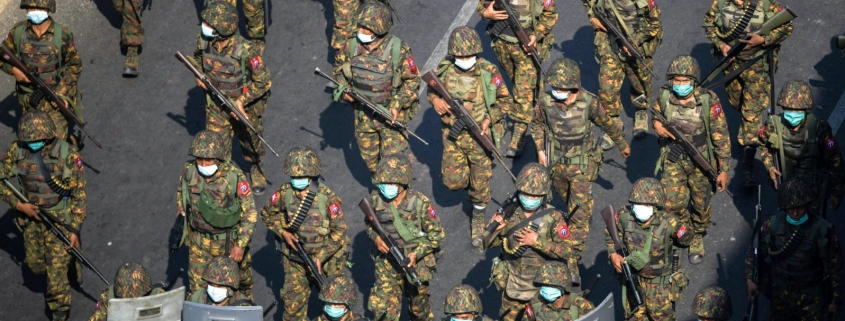Myanmar Junta, Armed Resistance Dig in For Long Slog
BANGKOK —
Fighting in Myanmar between the junta’s military and an ever-savvier armed resistance has hit a “deadly stalemate,” with both sides dug in but lacking the force for a knockout blow as violence continues to spiral, analysts say.
Rights groups say soldiers and police have shot and killed more than 1,200 civilians at ongoing protests against the military’s Feb. 1 coup against the previous, democratically elected, government.
Incensed by the bloody crackdown, dozens of communities across the country have taken up arms and formed so-called people’s defense forces to push back. Reports of ambushes, assassinations and bombings targeting the new regime are on the rise.
The military is stepping up the violence too, with a major offensive against PDFs across the northwestern part of the country over the past month that has driven tens of thousands of locals out of their homes amid reports of torture and sexual assault by junta forces.
Stretched out
In a recent report on the post-coup violence, the Brussels-based International Crisis Group said Myanmar had entered “a deadly stalemate” with “no end in sight.”
“However much the Myanmar military has been able to inflict casualties on PDFs, on civilian targets, arrests of underground groups — none of that, at least so far, seems to have done anything very much to cripple the resistance movement,” Richard Horsey, a Myanmar analyst and senior adviser to the group, told VOA.
“Rather the opposite; attacks have continued to escalate. So … I think Myanmar is in for many months, possibly years of this confrontation,” he added.
With some 350,000 troops, Myanmar’s military, known as the Tatmadaw, is among the largest in the region and battle-hardened by decades of fighting against ethnic armed groups vying for territory in the country’s borderlands. Between these groups and the new PDFs, analysts say the military has been stretched as never before.
“The Tatmadaw is facing security threats from all over the country” and “using its reserve forces and … auxiliary units to deploy to those areas,” said Min Zaw Oo of the Myanmar Institute for Peace and Security, a local think tank.
An independent report on the fighting last month by Matthew Arnold, former Myanmar country director for the nonprofit Asia Foundation, says the regime has even deployed traffic police from Yangon, the country’s commercial hub, against PDFs hundreds of miles away, and sent pro-junta paramilitary groups from outside Yangon into the city to root out urban insurgents.
Joining forces
Once disparate and ill-equipped PDFs have also started joining forces with one another and falling under the command of ethnic armed groups with better weapons and decades of guerrilla combat experience, the analysts say.
“That’s how these groups of PDF fighters who have come together since the coup, in some areas with very little history of fighting, with very little military experience, how they’ve been able to so quickly evolve into effective fighting forces,” said Horsey.
In Myanmar’s north, the Kachin Independence Army, one of the oldest and largest ethnic armed groups in the country, is posting its officers among some PDFs “to coordinate command and control,” said Min Zaw Oo.
In western Chin state, over a dozen PDFs have allied with the Chin National Army, another established ethnic armed group, to forge the Chinland Joint Defense Committee to coordinate their own efforts, a local PDF member, Salai Van Bawi Mang, told VOA.
“We are working closely and together in terms of military operations,” he said. “Mostly we [plan how] to fight together under one command, like one command and control system.”
He claimed that resistance forces have killed some 500 soldiers in Chin state alone since February and lost about 50 of their own members.
A spokesperson for the junta could not be reached for comment.
‘Spiral of violence’
Analysts say resistance forces are also picking up the pace of targeted killings of alleged junta informants and collaborators and of attacks on infrastructure, moving beyond mobile network towers to power cables, water lines and bridges.
In mid-September the junta itself said the PDFs and other “terrorists” had murdered 799 civilians in targeted killings since the coup, a figure the International Crisis Group says roughly matches its own count of assassinations reported by independent media.
Min Zaw Oo and his team counted another 190 reports of targeted killings in October, the most in any month yet. He said the assassins have started going after the family members of their prime targets as well, and that those fearing they may be in the PDFs’ crosshairs are also arming and hunting down suspected assassins, laying the groundwork for a dangerous new, communal “spiral of violence.”
Last month, the United Nations’ outgoing special envoy on Myanmar, Christine Schraner Burgener, said the fighting had swelled into a full-scale civil war.
Jason Tower, Myanmar country director for the U.S. Institute of Peace, said ethnic armed groups have been waging war with the military for decades but agreed with the envoy that a broader civil war Is taking root.
“What’s new is that the population has overwhelmingly expressed that it’s not going to allow military rule,” he told VOA, adding that the junta’s mass arrests and assaults on whole towns harboring insurgents was only feeding the resistance.
“It’s pretty clear that there’s a lot more people who are joining PDFs and continuing this struggle, so I don’t see it going away,” he said.



